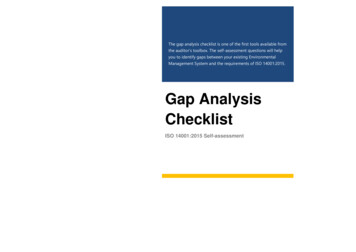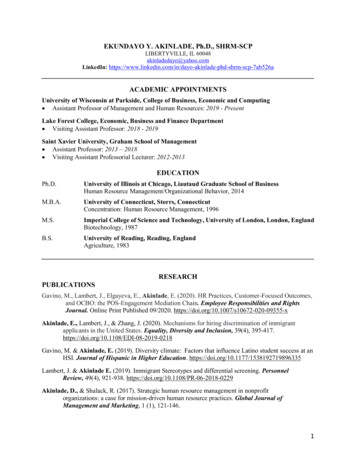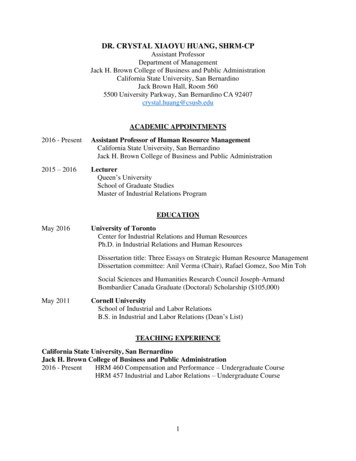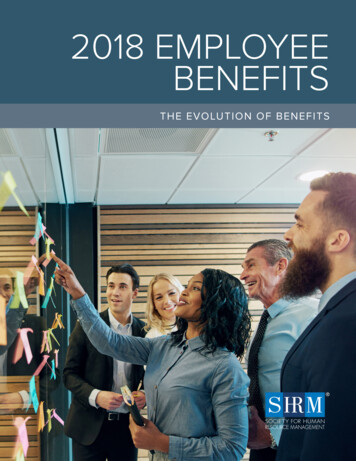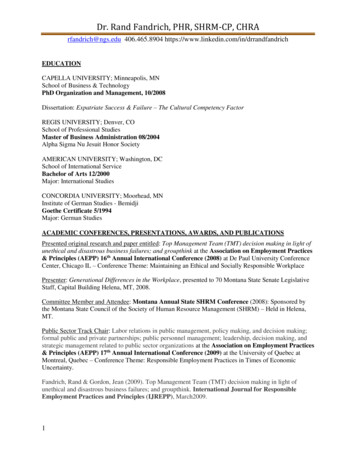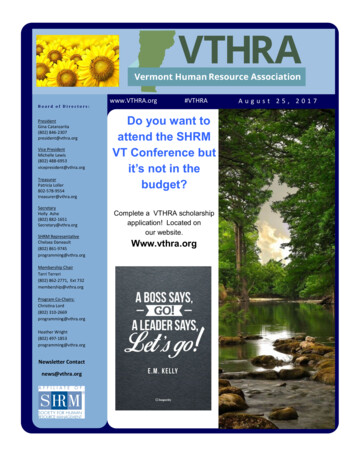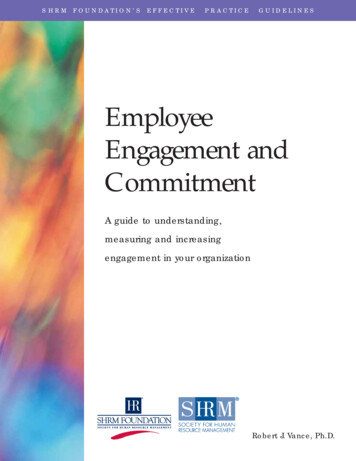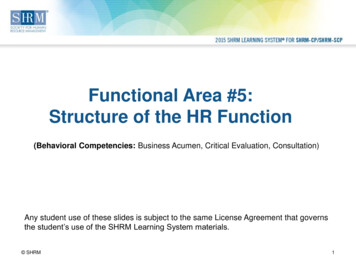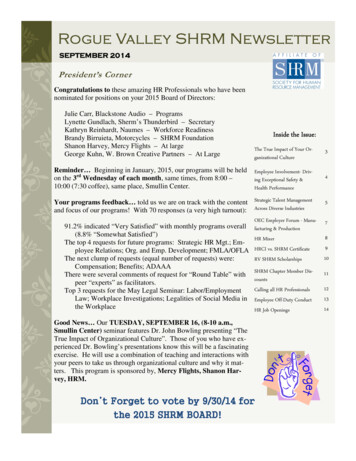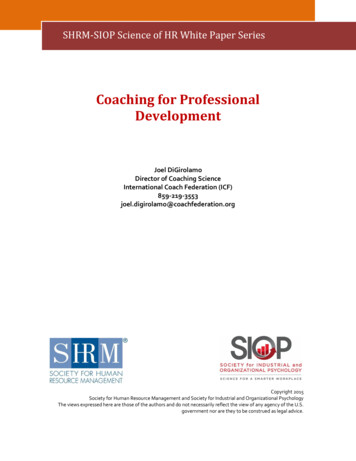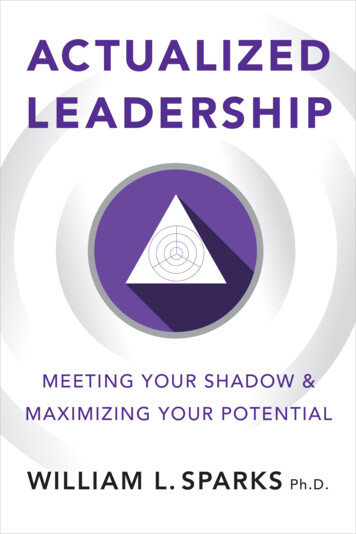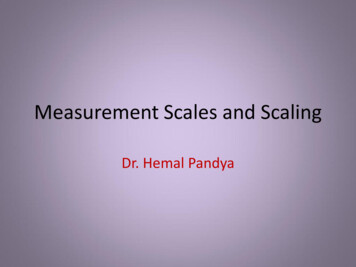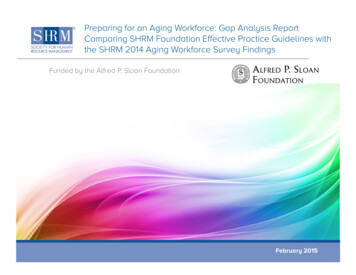
Transcription
Preparing for an Aging Workforce: Gap Analysis ReportComparing SHRM Foundation Effective Practice Guidelines withthe SHRM 2014 Aging Workforce Survey FindingsFunded by the Alfred P. Sloan FoundationFebruary 2015
Table of Contents SHRM/SHRM Foundation Aging Workforce InitiativeOverview of SourcesSummary of Key Practice GapsPart 1: The State of Older Workers in U.S. Organizations» Definitions and Terminology» Preparing for an Aging Workforce and Workforce AssessmentPart 2: Recruitment and Retention» Recruiting Mature/Older Workers» Retaining Mature/Older WorkersPart 3: Basic and Applied SkillsAbout SHRMAbout the SHRM FoundationAbout the Sloan FoundationThe Aging Workforce—Key Practice Gaps SHRM 20152
SHRM/SHRM Foundation Aging Workforce InitiativeSHRM and the SHRM Foundation have launched a national initiative highlighting the value of olderworkers and identifying—through original research—best practices for employing an agingworkforce. This three-year initiative is generously underwritten by a grant from the Alfred P. SloanFoundation.The purpose of this research is to: Investigate the current demographic structure of organizations and views on how thedemographic breakdown of their workforces is likely to change in the future in both theirorganizations and industries. Determine what, if any, actions organizations are taking to prepare for an aging workforce,including recruiting and retention strategies to specifically target older workers. Identify the skills and experience HR professionals most value in older workers.The Aging Workforce—Key Practice Gaps SHRM 20153
SHRM/SHRM Foundation Aging Workforce Initiative:Practice Gap Analysis Purpose of analysis:analysis: Identify gaps between the existing research on effective practices identified in the SHRMFoundation Effective Practice Guidelines series report The Aging Workforce: A Guide toLeveraging the Talents of Mature Employees and the practices currently being used byorganizations as identified in the SHRM Aging Workforce Survey.Survey Provide information that can be used by HR professionals and business leaders in their internalorganizational discussions on the implications of the aging workforce. To stimulate discussion and knowledge sharing on how to address the key practice gapsidentified.The Aging Workforce—Key Practice Gaps SHRM 20154
Overview of Sources: The Aging WorkforceEffective Practice GuidelinesThe SHRM Foundation’s Effective Practice Guidelines(EPG) Series—The Aging Workforce: A Guide toLeveraging the Talents of Mature Employees This report, part of the SHRM Foundation’s EffectivePractice Guidelines series, is written by Cheryl Paullin,Ph.D. Dr. Paullin, an industrial-organizationalpsychologist at the Human Resources ResearchOrganization, earned her doctorate from theUniversity of Minnesota. Dr. Paullin is also a Fellow ofthe Society for Industrial and OrganizationalPsychology and the American PsychologicalAssociation. In 2012, she co-authored a chapter onretention strategies for older/mature workers in theOxford Handbook on Work and Aging.The Aging Workforce—Key Practice Gaps SHRM 20155
Overview of Sources: The Aging WorkforceEffective Practice GuidelinesThe Aging Workforce Effective Practice Guidelines reviewteam included: Jerry W. Hedge, Ph.D.,Ph.D. senior research manager,Social and Statistical Science group at RTIInternational, North Carolina Anthony McDonnell, Ph.D.,Ph.D. associate professor,School of Management, Queen’s University Belfast,Ireland Betty Lonis, SPHR,SPHR, MBA,MBA vice president, humanresources, Navient, Indiana Celia E. Jarvis, M.S., SPHR,SPHR president and CEO,Quality Management Solutions Group, Ltd., Ohio Millicent BurkeBurke-Sinclair, Ed.D., MBA, SPHR,SPHR faculty,GodBold School of Business, Gardner-WebbUniversity, North CarolinaThe Aging Workforce—Key Practice Gaps SHRM 20156
Overview of Sources:SHRM Aging Workforce (Older Workers) SurveyThe following topics are included in the three-part series: Part 1: State of Older Workers in U.S. Organizations Part 2: Recruitment and Retention Part 3: Basic and Applied SkillsDefinition: In the survey itself, “older workers” were defined asemployees 55 years of age or older, in accordancewith U.S. Bureau of Labor Statistics (BLS) terminology.Survey Methodology: 1,913 HR professionals from SHRM’s membershipparticipated in the survey, with a random sample of18,000 from SHRM’s general membership and arandom sample of 2,000 from SHRM members ingovernment agencies. Response rate 9.9% Margin of error /-2% Data collection took place May-July, 2014The Aging Workforce--Key Practice Gaps SHRM 20157
Summary of Key Practice Gaps A shortshort-term mindset: Whereas The Aging Workforce EPG report advised taking a long-term view ofdemographic changes and the impact of an aging workforce (5 years and beyond), mostorganizations are primarily focused on assessing the impact of the aging workforce and the impactof retirements within a relatively short period of time (1-5 years). A lack of urgency around preparing for impending demographic shifts: Although the EPG reportoutlined a strong case for preparing for a major shift in workforce demographics in the years ahead,most organizations do not appear to have the same level of urgency in preparing for an agingworkforce. Most organizations are either at the early stage of examining the issue or believe that nochanges are necessary. Thirteen percent reported that they are not even aware of this potentialchange to the makeup of the workforce. A lack of formal longlong-term forecasting, planning and assessment related to changingworkforce demographics and an aging workforce: The EPG report recommended a number ofsteps in preparing for an aging workforce, including short- and long-term demographic forecastingand assessment or skills audits, but most organizations do not have a process for assessing theimpact of demographic changes in their workforce beyond the next one to two years. Older workers are not included in diversity planning related to recruiting: Whereas the EPGreport recommended building efforts to attract and retain older, more experienced workers intodiversity and affirmative action recruiting plans, over one-half of organizations reported that they donot actively recruit older workers at all.The Aging Workforce—Key Practice Gaps SHRM 20158
Part 1:State of Older Workers in U.S. Organizations Definitions and Terminology Preparing for an Aging Workforce and Workforce AssessmentThe Aging Workforce—Key Practice Gaps SHRM 20159
State of Older Workers in U.S. Organizations:Definitions and TerminologyThe Aging Workforce—Key Practice Gaps SHRM 201510
Definitions and Terminology:The Aging Workforce Effective Practice Guidelines Chronological age is not the best way to define an older worker. People vary in terms of when andhow they experience aging and whether they perceive themselves as aging. Factors that should betaken into account in addition to chronological age include physical, mental and emotional health;career stage; job tenure; and life experiences. The term “older worker” can evoke negative stereotypes. One of the best ways to combat ageism inthe workplace is to avoid negative—or potentially negative—terminology, whenever possible. Theterm “mature worker” is therefore also used to describe this demographic group. The term “older adult” refers to people age 65 and older who are not currently working. “Retiree” refers to those who have left the workforce—generally assuming these individuals are over55 years old, and often over 65.The Aging Workforce—Key Practice Gaps SHRM 201511
Definitions and Terminology:SHRM Aging Workforce Survey The term “older worker” was used throughout SHRM’s survey in accordance with BLS terminology. One-third (32%) of HR professionals reported their organization begins to consider an employee to be anolder worker when the employee is between 60 and 64 years old, another 17% between 65 and 69years old, and 7% when the employee is 70 or over. In general, HR professionals believed that employees consider an employee to be an older workerat a slightly younger age. About one-quarter of HR professionals reported employees begin toconsider an employee to be an older worker when the employee is between 50 and 54 years old(28%), between 55 and 59 years old (28%) or between 60 and 64 years old (24%). Less than 10% ofemployees consider an employee to be an older worker when the employee is age 65 or older.The Aging Workforce—Key Practice Gaps SHRM 201512
Definitions and Terminology:SHRM Aging Workforce SurveyAge at which most employees beginto consider a co-worker to be an “olderworker”40 - 444%40 - 449%45 - 4928%55 - 5924%60 - 6470 or over45 - 4928%50 - 546%65 - 69Age at which organizations begin toconsider an employee to be an“older worker” from a policy standpoint1%Note: 2014 n 1,913. Percentages may not total 100% due torounding.Source: SHRM Aging Workforce Survey: State of Older Workers in U.S. Organizations6%4%50 - 5414%55 - 5921%60 - 6432%65 - 6970 or over17%7%Note: 2014 n 1,647 Respondents who indicated “don’t know” werenot included in the analysis. Percentages may not total 100% dueto rounding.The Aging Workforce—Key Practice Gaps SHRM 201513
Definitions and Terminology:Key Gaps and Implications The EPG report advised that chronological age is not the best way to define an older worker, but HRprofessionals reported that almost one-half of employees begin to view workers as “older” as earlyas their 50s. Although the EPG report cautioned that the term “older worker” can evoke negative stereotypes, itremains the term most frequently used by the BLS and other official bodies, as well as byorganizations and HR professionals. The use of new ways of describing workers by agedemographics may therefore take time to develop. There is evidence of age norming and stereotyping among employees and even at the level oforganizations. Clearly, quite a few HR professionals perceive that employees view their co-workersas "older" at relatively young ages. For example, 69% of them reported that employees viewed theirco-workers as older before age 60, and 41% of them reported that employees view co-workers asolder by the age of 54. In contrast, when it comes to organizational policies and procedures, more HR professionalsperceive their organization to use older age ranges to define "older worker." This could be due topolicies and procedures that take into account definitions of older workers used in laws andgovernment regulations, such as age of eligibility for government-funded retirement programs. Evenso, 45% of HR professionals reported that their organization considers workers younger than 60 tobe "older."The Aging Workforce—Key Practice Gaps SHRM 201514
State of Older Workers in U.S. Organizations:Preparing for an Aging Workforce and WorkforceAssessmentThe Aging Workforce—Key Practice Gaps SHRM 201515
Preparing for an Aging Workforce and WorkforceAssessment: The Aging Workforce Effective PracticeGuidelines Over the next 15 to 25 years, in most industrialized countries, the Baby Boom generation will reachtraditional retirement age. Many of them will be able and willing to continue working, but many will alsochoose to leave the workforce. There are not enough people in the following generations to replace them.Therefore, organizations must realize that these older workers, regardless of their current employmentstatus, are a critical resource for meeting future talent demands. HR professionals must take the lead in removing barriers, such as age discrimination and negativestereotypes, that hinder mature workers’ ability to find and maintain employment. HR professionals must educate organizational leaders and employees that hiring or retaining matureworkers does not come at the expense of younger workers and that society benefits when experiencedworkers remain in the workforce longer. Retaining or retraining older workers may be more cost-effective for many organizations than recruiting,hiring, onboarding, socializing and training new hires. Mature and younger workers share many of the same needs and preferences, so HR practices that appealto mature workers are likely to appeal to younger workers as well. Paths to retirement are changing, and many people who retire from a first career are interested in returningto the workforce in some capacity. Organizations that shift their beliefs about traditional retirementtrajectories can take advantage of untapped supplies of qualified older workers. Helping workers achieve and maintain a healthy lifestyle can prevent or delay the onset of disablingconditions and their accompanying costs.The Aging Workforce—Key Practice Gaps SHRM 201516
Preparing for an Aging Workforce and WorkforceAssessment: The Aging Workforce Effective PracticeGuidelinesThe Aging Workforce Effective Practice Guidelines suggested that all organizations assess their workforces. Thethree essential steps to workforce assessment are:1.Conduct age and knowledge/skill audits:» Conduct an age audit by compiling information about worker ages and estimated time to retirement,and break out the data according to division, occupation and so on.» Conduct knowledge and skill audits, and document essential types of expertise required to carry outthe organization’s core mission and to successfully market its products and services to existing andnew customers.» Create a turnover risk map by asking leaders at each level of the organization to judge the degree towhich each of their subordinates is critical to the organization’s mission and the likelihood that eachperson will leave the organization within the next one, two or five years.2.Identify work requirements: What does the organization need?» Consider the type of work that workers will be expected to perform, and determine how best toleverage the talent pool.3.Gather information from workers: What are their needs and wants?» For current employees, use a structured approach to ask about factors that would help them continueworking as they grow older or about their anticipated time frame for retirement. Do this in a safe andnonthreatening manner to encourage frank responses and to avoid engaging in discriminatorypractices (e.g., do not pose such questions only to workers above a certain age). Supplement thisinformation with published results from large-scale surveys, research on drivers of engagement andresearch on factors that influence the decision to retire.17The Aging Workforce—Key Practice Gaps SHRM 2015
Preparing for an Aging Workforce and WorkforceAssessment: SHRM Aging Workforce Survey Just over one-third of respondents (36%) indicated their organization was preparing for the projectedincrease in the proportion of older workers in the labor force by “beginning to examine internal policiesand management practices to address this change.” One-fifth (20%) of respondents said their organization had examined their workforce anddetermined that no changes in their policies and practices were necessary. Another one-fifth (19%) of respondents said their organization was just becoming aware of thispotential change (in the ratio of older workers). Few HR professionals believed the potential loss of talent due to retirement of workers is considered “acrisis” or even “a problem” in their industry. One-half of HR professionals said their organization tracks the percentage of employees eligible toretire in the next 1-2 years, and fewer still beyond that time frame. Organizations were more likely to have conducted strategic working assessments of variousaspects of their future workforce in the 1-2 year time frame than for 3 years and beyond.The Aging Workforce—Key Practice Gaps SHRM 201518
Preparing for an Aging Workforce and WorkforceAssessment: SHRM Aging Workforce SurveyHow Organizations Are Preparing for the Projected Increasein the Proportion of Older Workers in the Labor Force*Beginning to examine internal policies and management practices toaddress this change36%Have examined our workforce and determined that no changes in ourpolicies and practices are necessary20%19%Just becoming aware of this potential change13%Not aware of this potential change6%Have implemented specific policies and management practices5%Have proposed specific policy and management practice changesHave agreed on a plan to change policies and management practices2%Note: n 1,715. Percentages may not total 100% due to rounding.* Question as asked in the survey: “According to the Bureau of Labor Statistics, workers 55 years of age and over are projected to make up approximately 26%of the labor force by the year 2022, compared to 21% in 2012 and 14% in 2002. As the proportion of older workers increases, the potential impact resultingfrom the loss of their knowledge and experience may become more substantial. Which of the following best describes your organization’s preparation for thischange?”Source: SHRM Aging Workforce Survey: State of Older Workers in U.S. OrganizationsThe Aging Workforce—Key Practice Gaps SHRM 201519
Preparing for an Aging Workforce and WorkforceAssessment: SHRM Aging Workforce SurveyOverall Impact of the Potential Loss of Talent as a Result of Older Workers Retiring or LeavingTheir Organizations for Other Reasons Over the Next . . .Impact on Industry1-2 years (n 1,592)3%18%3-5 years (n 1,612) 4%6-10 years (n 1,532)11-20 years (n 1,396)33%24%8%46%41%28%13%It is a crisis32%41%26%34%It is a problemIt is a potential problem23%26%It is not a problemImpact on Organization1-2 years (n 1,785) 4%17%27%3-5 years (n 1,800) 3%24%6-10 years (n 1,687) 7%28%11-20 years (n 1,499)12%27%It is a crisisIt is a problem53%38%40%34%It is a potential problem35%24%28%It is not a problemNote: Percentages may not total 100% due to rounding.Source: SHRM Aging Workforce Survey: State of Older Workers in U.S. OrganizationsThe Aging Workforce—Key Practice Gaps SHRM 201520
Preparing for an Aging Workforce and WorkforceAssessment: SHRM Aging Workforce SurveyTracking Employees Eligible for RetirementDoes your organization track thepercentage of workers in your organizationeligible to retire in the next . . .1-2 years50%3-5 years45%6-10 years11-15 yearsApproximately what percentage of yourworkforce will be eligible for retirement inthe next . . .25%17%Note: n 1,815-1,872. Percentages do not total 100% due to multipleresponse options.Source: SHRM Aging Workforce Survey: State of Older Workers in U.S. Organizations1-2 years (n 855)3-5 years (n 768)6-10 years (n 416)11-15 years (n 270)10%14%20%23%Note: n 270-855. Percentages do not total 100% due to multipleresponse options.The Aging Workforce—Key Practice Gaps SHRM 201521
Preparing for an Aging Workforce and WorkforceAssessment: SHRM Aging Workforce SurveyPercentage of Organizations That Have Conducted a Strategic Workforce Planning* Assessment to . . .58%52%44%35%31%21%17%Analyze the impact of workers aged 55 leaving your organizationIdentify your future workforce needs1-2 yearsn 1,551-1,65139%n 1,542-1,6913-5 years20%Identify your potential skills gaps6-10 yearsn 1,529-1,666*Strategic workforce planning is a process used to ensure an organization takes into account the future loss of knowledge through employeeresignations/retirements and the projected knowledge/personnel resources required to achieve the organization’s goals.Source: SHRM Aging Workforce Survey: State of Older Workers in U.S. OrganizationsThe Aging Workforce—Key Practice Gaps SHRM 201522
State of Older Workers in U.S. Organizations:Key Gaps and Implications The EPG report outlined a strong case for preparing for a major shift in workforce demographics inthe years ahead. However, organizations do not appear to have the same level of urgency inpreparing for an aging workforce. Most organizations are either at
Preparing for an Aging Workforce: Gap Analysis Report . consider an employee to be an older worker when the employee is between 50 and 54 years old (28%), between 55 and 59 years old (28%) or .File Size: 738KB
